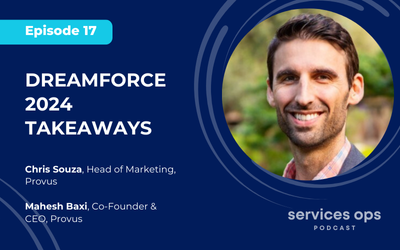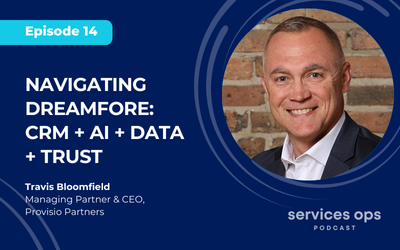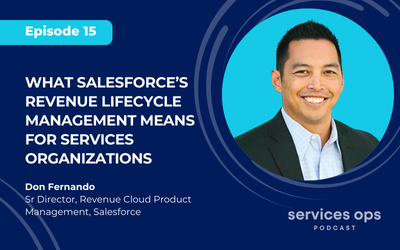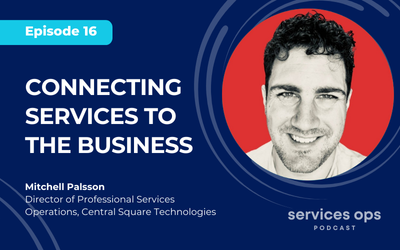Episode 17: Dreamforce 2024 Takeaways: Agentforce, AI, Services Operations & More
Meet Our Hosts
Mahesh Baxi is the Co-founder and Chief Executive Officer of Provus. As one of the original innovators of Services CPQ, he is responsible for furthering the company’s leading position in the Services Economy. He is a proven leader with over 25 years of management experience scaling the IT, product, and services operations for global software companies.
Chris Souza is a senior B2B marketer leader who drives revenue through holistic growth marketing strategy, operations, and demand generation. Progressive experience owning multiple key disciplines within the marketing umbrella has provided me with a unique fluency in key skills, data, and operational connectivity.
Transcript
Introduction of Agentforce
00:07
CHRIS: All right. Hello everyone and welcome to the Services Ops Podcast. The best podcast dedicated to the people, process and technology of operating a great services business. And we’ve got a wonderful episode to hear today, with me as always, co-founder, CEO co-host, Mahesh Baxi. How are you doing Mahesh?
00:26
MAHESH: Good morning Chris, doing very well. Looks like we have a lot to talk about Dreamforce that just happened a couple of weeks ago.
00:34
CHRIS: I know it seems like it was further away than just a couple of weeks ago and Dreamforce is one of those things where there’s a really big buildup coming into it, an exhausting week, and then you move forward. But it was only a couple weeks ago and so there’s still a lot to talk about. A lot of takeaways, especially for services organizations. And what we’re gonna do today is we’re gonna share some of our reflections on the impact of some of the big announcements that came out of Dreamforce, as it relates to services operations, and some of our own personal ones. You know, we were there on the floor having conversations with all kinds of organizations for, for multiple days. So we have some interesting takeaways. So let’s just jump straight in. I think the biggest news, right Mahesh, the biggest news is Agentforce, right? Agentforce is here. It was Agentforce. It was something Salesforce tends to do every year, where you think of one thing going into the show, then you walk onto the floor and you see these really big signs about something you might never have heard of before. And this year is Agentforce.
01:37
MAHESH: Yeah. You know, every year I go to Dreamforce and I think, what’s next? Like, what new can they do? Right? And so much is already done. And this, you know, but I have to be honest, I think this year was probably one of the best executed messaging across the board, right? It was a story. It was very impactful, very meaningful. The Agentforce saying is how AI can actually help humans and empower humans and not take over what humans do was a master stroke, as you always expect from Marc Benioff, right? Yeah. I mean, he’s a master at this kind of stuff. So I think Agentforce was really great. At first when you hear about Agentforce, you’re like, there’s Salesforce and now there’s Agentforce. But as you dive deeper into it, I think what they’ve been able to achieve combining the technologies of their advanced analytics Einstein AI, OpenAI integration that I’m assuming has been done, and then ability to manipulate the LMS inside the Salesforce environment and manipulate your kind of organized data that obviously sits on the Salesforce platform and unstructured data and be able to combine both of those and drive productivity through variety of different Agentforce, what do they call it? Agentforce AI Bots, right? I think it has been just amazing. It’s pretty impressive.
03:26
CHRIS: Yeah. And I think the difference this year compared to the last couple years was in the last couple of years was just AI, right? AI, AI. And this year, Agentforce shows up and puts it all into a nice wrapper of understanding, right? There were lots of examples of how AI can interact with your customers, interact with your teams to make them more productive and like true examples and true outcomes. So it wasn’t just about having AI this, the messaging of still needing trusted data. You need to organize structured data that was still there, that was still a very important pillar, but this time it was about what does it look like, right? It’s not just about having AI anymore, it’s about having these results and these results of engaging with the customer in a quick and accurate way. Focusing your team in the right places at the right time so that you can serve your customers better guardrails that you can put around the agents, the channels that you’re gonna, put the agents live in so they’re engaging with whomever they’re engaging with. So it was definitely a different approach this year. It made more sense, right? AI now makes more sense. And I like that because the last couple years has just been AI, and we’ve been saying this for a while, “what’s the purpose”? Right?
04:55
MAHESH: And now you can actually see it in action, but what’s even more impressive in this timeframe, when they launched Agentforce, they actually launched it where the businesses can build their own agents using a simple business-like language. Right? Sure. I mean, if you have more complicated or complex use cases, you do need some help either from your IT or consulting forms or whatever. But at least simple use cases, you can start building your own AI agents. And that’s the power of Salesforce. That has always been the power of Salesforce, which is a high degree of configurability. Taking control in your hand as in the businesses or IT’s hand and not being dependent on someone, right? So that’s just been pretty impressive to see in action.
What AI & Agentforce mean for Services Organizations
05:48
CHRIS: Yeah. Definitely. Now, let’s talk a little bit about what this means for services organizations. You know, I think there are some services businesses that are going to want to jump in right away and start investigating and saying like, “hey I think I found applications for these.” You know, if you’re in managed services and you have incoming IT tickets coming from random customers all the time you’re gonna want to think about what Agentforce means for you. If you’re custom projects and delivery, maybe you start thinking about how it makes your delivery teams more productive and how they’re engaging with your Salesforce data in a different way. Maybe it’s not as high a priority. What do you think?
06:27
MAHESH: Yeah, I think when we talk about services, organizations there are different kinds of services organizations and different kinds of needs, right? One is, let’s talk about fulfillment of your services. Now with fulfillment of services is where kind of tickets get generated, and you have to respond to those tickets and stuff like that. Now, it’s a wonderful place to really use Agentforce and automate that entire process as best as you can. I mean, before it actually touches the human, maybe you might be able to get through 60-70% of the conversation and answers and all that stuff. And then the other 30%, 20% you probably need humans to be involved, right? So that’s a great use case. Talking about the front end part of the services and services companies, which is how does this help putting your proposals in front of a customer? How do you make sure that you are using all of these technologies to put a proposal in front of the customer in a meaningful way? Now, this is where Chris, you know at Provus we actually launched our advanced analytics and AI module, also known as Provus Intelligent Quoting Module. And we have been able to kind of in real time as Salesforce was busy launching Agentforce. We were busy integrating all of that into our product as well, and some amazing use cases. Let me step back a little bit. The reason why Agentforce is so powerful and so exciting is it has power to combine structured and unstructured data through the LLMs that you can configure and customize for your own needs, and it’s able to understand the combination of structured and unstructured data and able to answer and respond to you and take the appropriate action. Now we have been toying around with the OpenAI ChatGPT for a while. ChatGPT is great in terms of understanding the language, understanding the content, and understanding the unstructured data. But the moment you try to combine unstructured data with some structured data to interact with the system, it’s just random. You have to be lucky to get the right kind of results, right? But with Agentforce and Salesforce Einstein AI, now you actually have the power to combine. So I’ll give you an example. What we have done with these technologies is now you are able to actually go into the system and say “hey I want to create a proposal for Acme International for implementation service, support service and managed service.” This command otherwise is probably 15 different clicks, right? And be able to answer that. Now you are starting to, and the system now understands what this means through the LLM models, and it’s actually able to create a proposal for you. It’s able to understand what that means. It’s actually giving you a first baseline proposal with just that one command. Now, you can start interacting and say, “oh, I’m going to have five from a scope perspective and I’m going to have five integrations. So can you please update that in the scope.” Right? So now you start to see the power of Agentforce and different applications of Agentforce. This is where productivity comes in, right? So the productivity is instead of me going through and answering now as a human, I’m just interacting with the system as another human like Chris, if I tell you that, “Hey, Chris, can you please create this proposal for me with these three services?” That’s what you as a human would understand and do a bunch of things. That is what the system is able to do now for you. But at the same time, you are able to now customize or configure your proposals just by directly interacting with the system. That’s one set of power with what Agentforce and the combination of technologies that they released can do. The second part of this where Provus has been able to implement is what we call kind of near one of our AI strategy, which is we have, our strategy is called D2P2 strategy, which is: Descriptive, Diagnostics, Predictive and Prescriptive, right? The part of the prescription which comes in is for complex deals that our customers negotiate or put together. These are multi-year deals, multiple different services, very large work breakdown structures, different resources, different resource locations. Now, in this kind of situation, you have your guardrails. You talked about guardrails earlier. So I know that the customer has a $3 million budget. I know internally my CFO has given me a guardrail that I cannot go below 56% margin. I can do a lot of mathematical mumbo jumbo to get to that, but I do not know whether what I put together really is something that stands true in reality. In other words, did I create a delivery risk? Did I actually put in resources that I should’ve not? Am I using resource locations from places where I don’t even have resources, right? You don’t know any of that stuff. Now you’re able to interact with the system and say, “Hey, can you please create a scenario for me with these guardrails?” This is again, the power of where AI technologies come in and how Provus has been able to integrate these technologies with our quoting system. Now we are able to put those guardrails and say, okay, gimme a scenario. The system now actually crunches through all of your historic sold data, how you have executed those projects, and get the best possible combination with the guardrails that you have asked for. And now it is able to give you a scenario saying that, “Hey, here is the closest match that I can get to your 56% margin, $3 million top line, and here are all the services that you should include. Here is the estimate or scope that you should include” and stuff like that, right? So that’s the power. That’s super exciting actually what these technologies can do now for services businesses.
12:24
CHRIS: Yeah. Yeah. And I like that example of the guardrails. It helps take what was talked about at the show a lot guardrails and how the agents are interacting with your customers. Those guardrails are one type of guardrails. Like you don’t want them to go into certain subjects or you don’t want ’em to like to insult your customers. Like those types of guardrails, which a lot of people are hesitant about around AI because you’re trying to have an AI agent, interact with a human, where there’s plenty of other types of applications of AI in different guardrails. So using guardrails of a revenue per preference or a margin guardrail brought down from the CFO organization, right? Those are different types of AI guardrails. So when you’re approaching AI as a services operator in whatever capacity, you don’t need to be ringing your hands and worrying like, “Ah, AI is gonna say the wrong thing to my customers.” There’s plenty of other applications you can go into and you can start to get really comfortable with the technology.
Learnings from the Dreamforce Floor
13:29
CHRIS: Yeah, all right. So let’s move on to our learnings from the floor, right? Tens of thousands of people attend this show. It feels like I talked to tens of thousands. I’m sure you feel like you talked to tens of thousands over a three day period. But I thought it was an interesting time to hear from this audience. So let’s, let’s kind of go back and forth a little bit. What’s one thing that you took away from all of your conversations?
13:55
MAHESH: I think, you know, yeah you are right. I mean, this time I felt the arrangement was slightly different compared to the previous years. But you are right. I mean, it feels like tens of thousands of people stop by and were on the floor at any given point in time. Which is something that I love about Dreamforce. I think two things stood out, right? I mean, a bunch of people walked in saying, “Hey, I see that you have a demo for RLM and Provus” and “Hey we just heard about RLM in some sessions. What is RLM and how do you integrate with RLM”? Right? So that was one kind of theme that I heard. And the second one was like, “Hey Agentforce is everywhere. You are talking about AI, what are the use cases in the services quoting?” Which is what we just talked about, right? So let me spend a couple of minutes on RLM. RLM is “Revenue Lifecycle Management”. That’s a re-architected, rebranded Revenue Cloud product that Salesforce launched during Dreamforce. Again, another master stroke in the sense that it now allows organizations to go end-to-end when they talk about revenue lifecycle management. It allows you to automate your CPQ processes, the product CPQ processes. It allows you to do contract negotiations using CLM. It allows you to do order management. It allows you to do invoicing, billing, and of course it’s Salesforce. It’s integrated into any kind of backend fulfillment system. Now in real time we actually integrated with RLM because of the use cases, there are lots of companies out there which are selling software products and services that go along with those software products. There are a lot of companies which are selling hardware products and the services that go along with the hardware products, and there are a whole lot of other companies which are selling hardware, software and services together. Now, what RLM is able to do effectively is be able to automate your software selling process through this product CPQ or be able to automate your hardware selling process through the product CPQ. What they can’t effectively do is the services selling motion, which is where the integrated approach of RLM and Provus comes in. And with this integrated approach you get one seamless user interface from a user perspective. You get to orchestrate the entire journey from one place, but at the same time, you now are adding your software products and hardware products to the cart, you’re able to add services that you want to sell or recommended services that comes along with what hardware and softwares you’re selling to the cart and configure your services directly from the cart using Provus, right? Provus basically is the backbone of how you do your bottom up services quoting details about services you are selling, work breakdown structures, the entire deal structure for services, complex discounting, pricing adjustments, all of that stuff. You’re able to do all of that through Provus in an integrated manner. And the beauty of integrated approaches, all of that is real time updated in your cart so that the seller, the CXOs, the approvers, all of them have one view of the entire deal being put in front of the customer in terms of your software services, hardware services or software, hardware and services. And again, to us, it’s super exciting because now the customers on the back of RLM plus Provus, they are truly able to automate their lead-to-cash journey, which includes services, right? So that’s the exciting part here.
17:49
CHRIS: Yeah. Yeah. I think that’s really exciting. And something I took away from the floor a little bit different is two sort of key takeaways for our audience. And one is to absolutely maintain your curiosity. And we were sitting there on the floor, and I’m gonna use our example, and this happens all the time, but on our booth, we had things like Services CPQ up there, and a lot of times people walked by and they stopped and they said, “Services CPQ?”, and they’re like, “What? I know CPQ, but what is Services CPQ?” And you’d have a conversation and you’d explain, and sometimes it’d be applicable to the business, and other times it’d be like, “We have that challenge. Like we, that’s exactly our challenge that we have, and that’s why it’s not working.” And that’s what it is. And I think that’s a really good example of doing your best to maintain your curiosity and don’t be scared to search for specific solutions at times other than three days in the year at Dreamforce, right? Like, there are, as a services organization, we know that the challenges services face are unique and nuanced. So don’t be afraid to search for unique and nuanced solutions. Don’t settle into this, “ugh, I just gotta make it work.” Like there’s a good chance there’s something out there for you. So that’s one. And then two, don’t assume that everybody on your team is on it. So the majority of these folks say “Service CPQ, what’s that?” They’re the Salesforce leaders of their organization. They’re the admins, they’re the architects, they’re the heads of IT. They work really hard, but they might not know everything about what Salesforce has to offer, or what can be accomplished, right? So if you see something that’s interesting, say something, bring it to your teams. Don’t assume that when you go to your IT function and say, “Hey, I have this challenge, can you help figure it out?” that they know about the specific services solution or where it’s gonna be? Right? So I think those are two key takeaways I had. I was like, it’s just interesting that there are very knowledgeable people all over the place, and sometimes things just slip through the cracks and people do the best Google searches they can sometimes and sometimes they don’t. So just maintain that curiosity 365 days a year and if you think you have a problem and you see something that could be a solution, say something. Don’t assume that the people that are there are in charge of IT know about it.
20:17
MAHESH: Yeah, I agree a hundred percent.
20:19
CHRIS: Yeah and besides that, you know, I think I had some good chicken sandwiches over the days and make sure to get your coffee in the morning because it kind of disappears in the mid-morning. And all the fun little Dreamforce insider tips, we have those, if you ever wanted to reach out, we can talk about those too.
20:38
MAHESH: But you know, the Salesforce team knows how tiring Dreamforce can get. And they always make it super sweet for you. So this year they had Imagine Dragon and Pink, right? They were performing. Then they had John Mulaney.
20:57
CHRIS: Yeah. He was funny.
20:59
MAHESH: And so every day they just put up these amazing shows that just kind of takes your tiredness away at the end of the day, which is phenomenal.
21:08
CHRIS: Yeah. And as far as I can tell on the last day, I was tired. I needed to go catch a boat to get home. Everything was closed. And I walked up onto Folsom Street and there was Benson Boone, who is like the guy right now, and he’s like one of the top pop stars in the world right now. And he’s screaming in his high pitched voice and singing a song right there on Folsom Street just for a couple thousand folks. I paused, and I was like, “oh, I can risk losing or missing this ferry for a few minutes.” Yeah and Dreamforce gets it, right? So they keep you energized, they keep you going. Salesforce gets it. They come out with things like Agentforce and RLM, but it’s still a big universe out there and services face a lot of different nuances and challenges, and Salesforce has lots of different nuances to it. So don’t stop being curious and keep going for it. Right?
22:03
MAHESH: Absolutely. I’m looking forward to the next Dreamforce already. But if you are in the audience, if you’re listening to this, and if you are doing any kind of offering, any kind of services to your customers, I think you know, give us a call, reach out to us. I’m pretty sure we can help you irrespective of the maturity of your processes where you are at.
22:25
CHRIS: And we, if we can’t, we know somebody that can, right? Like that’s the whole purpose of this right. People, processes and technology. So, well that’s, that’s it for this episode, our Dreamforce recap. We look forward to our next one. Some special guests coming up in the future. And until that time, like and subscribe. Thank you for your time. Thank you for your viewership and listening and go out and be a courageous services leader.
Subscribe to the podcast
Subscribe to our dedicated podcast email newsletter for the latest episodes:
Complex service quotes? No problem.
Access materials that illustrate the need for a unique solution for services quoting.
Episode 15: What Salesforce’s Revenue Lifecycle Management Means for Services Organizations






